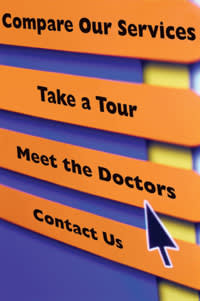Building a Better Web site
Creating an interactive Web site that stands
out could bring new patients into your practice.
ROBERT
C. SILKEY

As a result, it has become not only necessary to have a Web site, but to own one that will set you apart from the sea of choices that come up in the results of a keyword search. In looking to make a potential ophthalmic practice stand out, there are several interactive features in the Web development marketplace that can help.
Five of the newest and most effective of these products are:
-
auto-responders
-
push-to-talk
-
video patient evaluators
-
streaming video library
-
virtual tour
This story will focus on these features defining them and explaining the costs and benefits of these interactive tools.
Web Features
Auto-Responders. These are automatic responses and information sent to a patient or potential patient who has requested information through a form on the practice's Web site. This information is stored in a library of responses and is triggered to send information automatically to the potential patient based on boxes checked or choices made from a pull-down menu on the form they have submitted.
Information that can be sent by auto-response includes:
-
map and directions
-
brochures of procedures
-
finance applications/information
-
pre or post-op instructions
-
new patient forms or medical history forms
-
practice newsletter

Push-to-Talk. This interactive feature enables the patient or potential patient to phone the practice directly from the practice Web site. When requested, the patient simply enters their phone number and clicks a button to connect to the practice.
The software then connects the phone from the practice to the number entered by the person requesting the connection.
Statistics are then provided for the practice as to how many visitors on the site used the feature, the duration of each call, the phone numbers of those visitors and which party ended the call. These data enable the practice to more easily track Internet patient leads.
Several companies in the Web development marketplace offer the push-to-talk feature. The costs associated can be billed monthly, per minute or as a one-time setup fee with annual renewal. Costs may increase by $500 to $1,500 if the push-to-talk window is customized to match the company Web site, logo and artwork.
Video Patient Evaluator. The video patient evaluator is an interactive form on the practice Web site initiating a more personal introduction and education about the practice by the use of "TV" style video stream. It enables the doctor to personally introduce themselves and the other members of the practice while gathering information from the potential patient. The video patient evaluator allows the patient to select questions about the practice and the specialized procedures being offered; the video answers those questions while storing the information that is being requested.
The information is then sent to the practice in a digital format (via e-mail) so that they may then call the potential patient for follow-up and scheduling. Several companies offer the video patient evaluator, which consists of streaming video or flash imaging. Although these features work for dial-up and high speed Internet connections, video files may falter for some Web visitors using dial-up. The investment required for adding the video patient evaluator to a Web site can range from $15,000 and up.
Streaming Video Library. Streaming video is a way for a Web site visitor to view actual or virtual surgeries, and receive education through a visual video of a procedure being offered in the practice. A Web site can also house a library of diagnosed disease or condition information with educational videos that can be opened and viewed by the visitor. Not only does this set realistic expectations of the surgical procedure, but the information can give a patient an idea of how the physician or staff performs the procedure. If an actual surgical video is not available, there are companies offering educational videos and libraries that can be purchased by practices to use for their Web sites.
Virtual Tours. Many patients may be interested in the practice facility when choosing a physician. The virtual tour enables the visitor to see different areas of the practice via video or images linked together on the Web site. Some virtual tours allow the visitor to navigate through while others are simply a video tour and the visitors choose which areas they are interested in viewing. This also sets a realistic expectation of what their office experience will be like.
The fees associated with the addition of streaming video and virtual tours vary greatly. Many Web development companies offer these products and services; the price they charge is usually based on how much production time is required, the length of the videos themselves and if customization occurs outside of their pre-determined format.
Benefits of a Better Web Site
Adding these simple interactive tools to a Web site has many benefits. An interactive Web site makes the visit memorable, creates an impressive first impression and keeps the visitor in the site longer, increasing the amount of people contacting you by phone and e-mail.
The conversion rate of Web site visitors to patients is increased because of the impression and information given. Your Web site's features can effectively communicate to first-time visitors the knowledge they need about their conditions and answer questions about your practice. In the end, this benefits you by having one more way of setting your practice apart from the competition.
Robert C. Silkey is the president and CEO of Einstein Medical, which provides Internet development to physicians and dentists. For more information call (800) 600-0003 or e-mail info@einsteinmedical.com.








